An efficient synthesis, characterization and docking studies of 2-Methoxy-3-(1-substituted-1H-pyrazol-3-yl)quinoxalines
A basic, proficient and P-TSA catalyzed synthesis of quinoxalines beginning from ethyl 3-methoxyquinoxaline-2-
carboxylate in great yields is introduced. All the compounds synthesized were analyzed by spectral analysis.
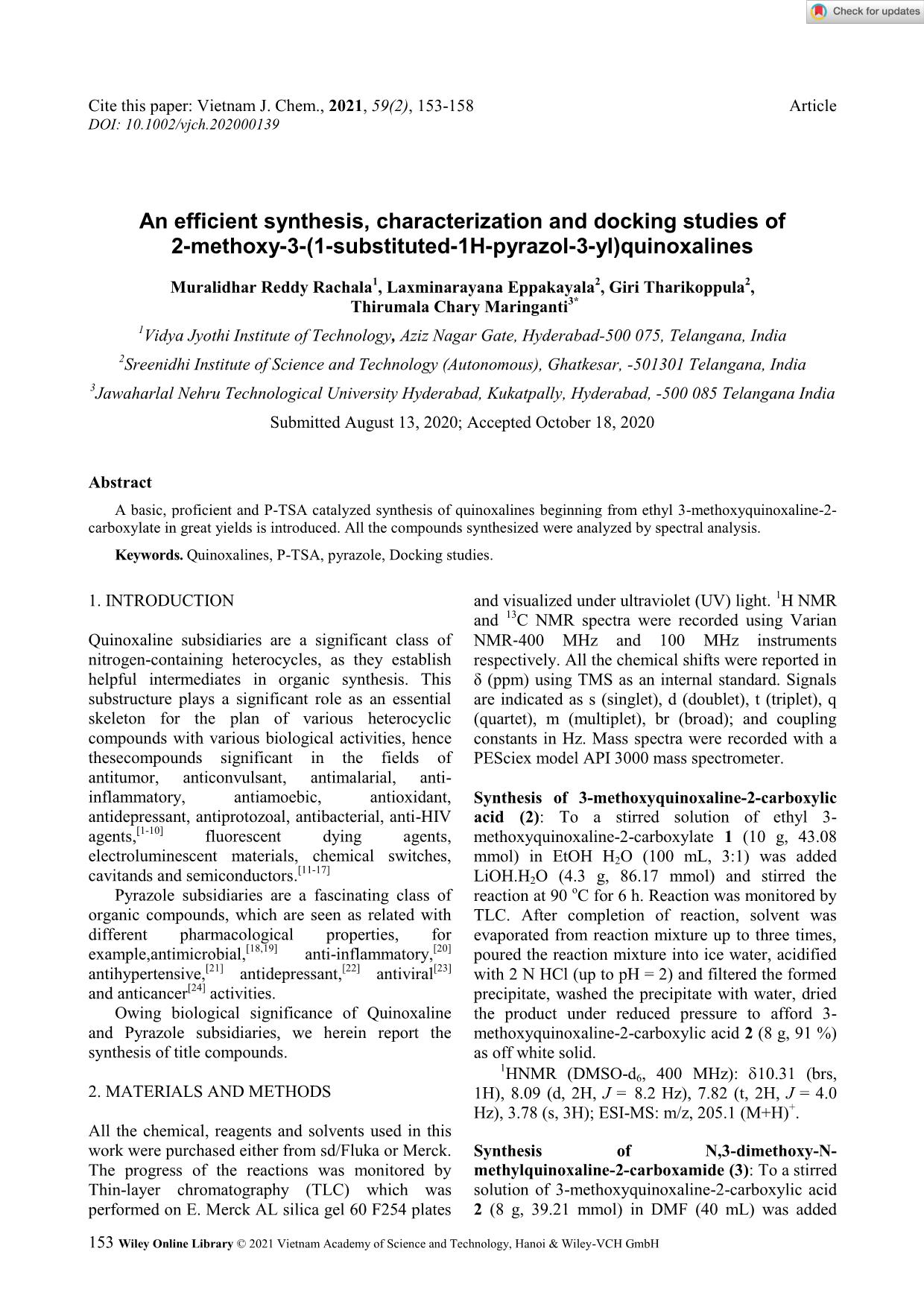
Trang 1
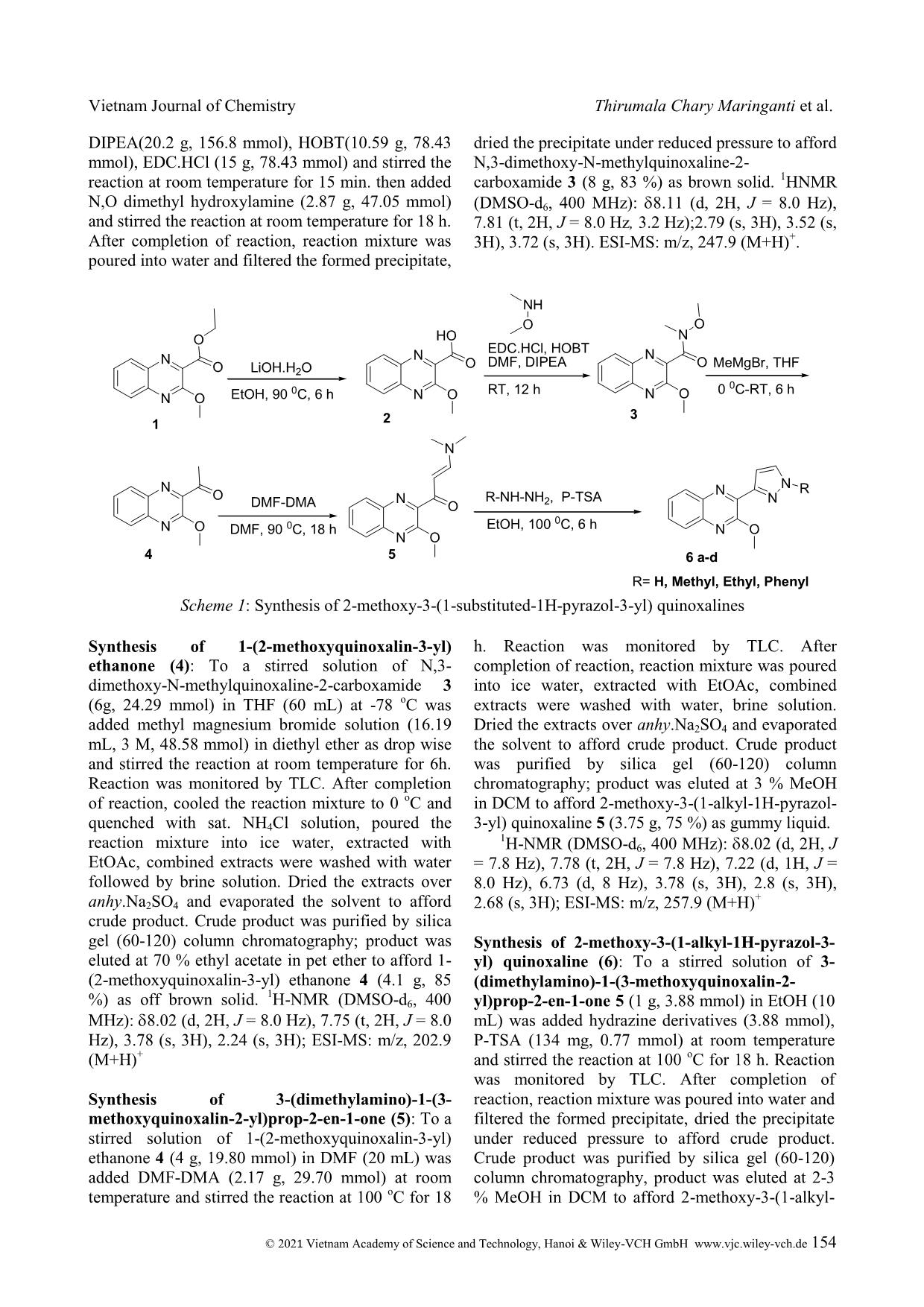
Trang 2
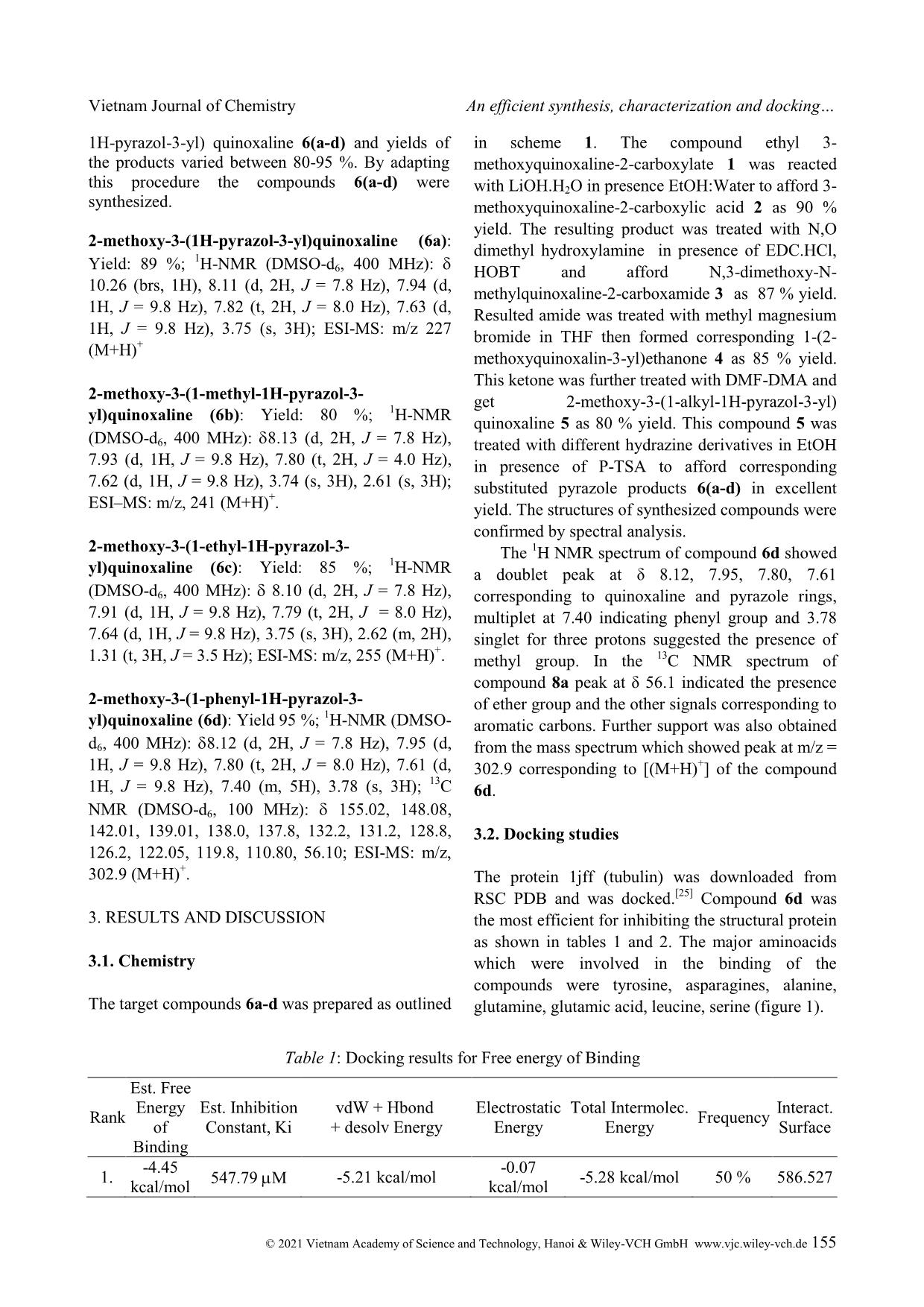
Trang 3
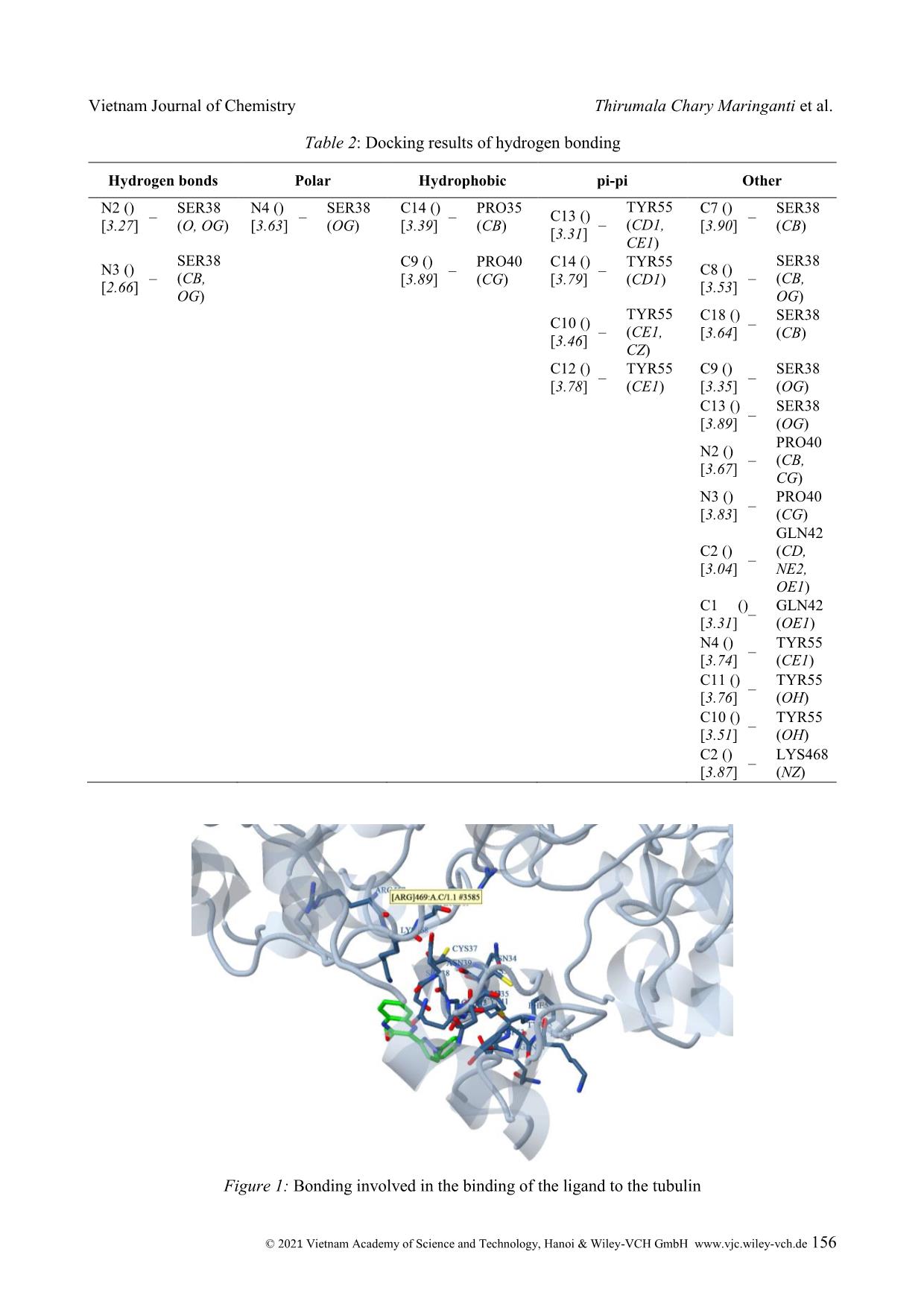
Trang 4
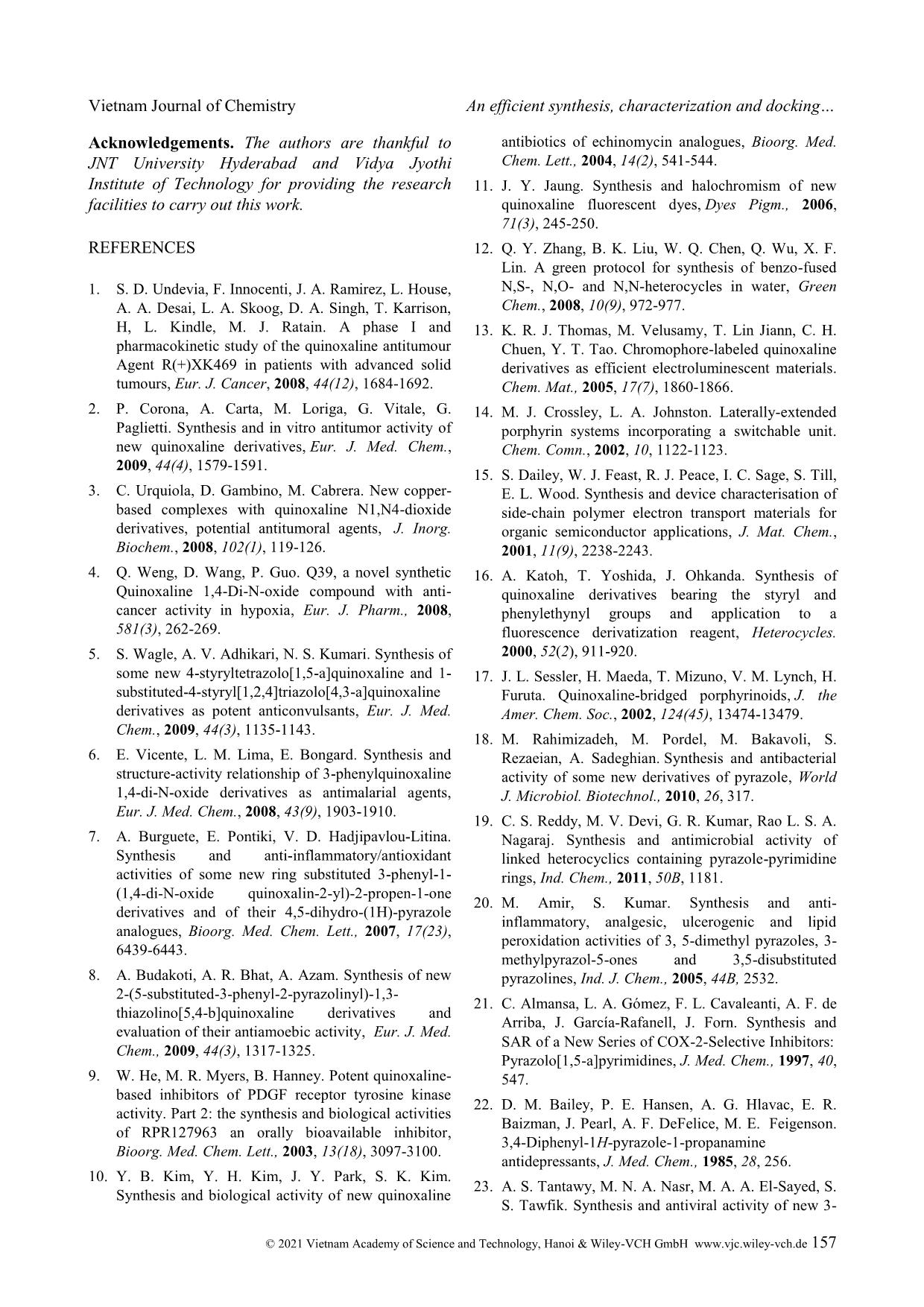
Trang 5
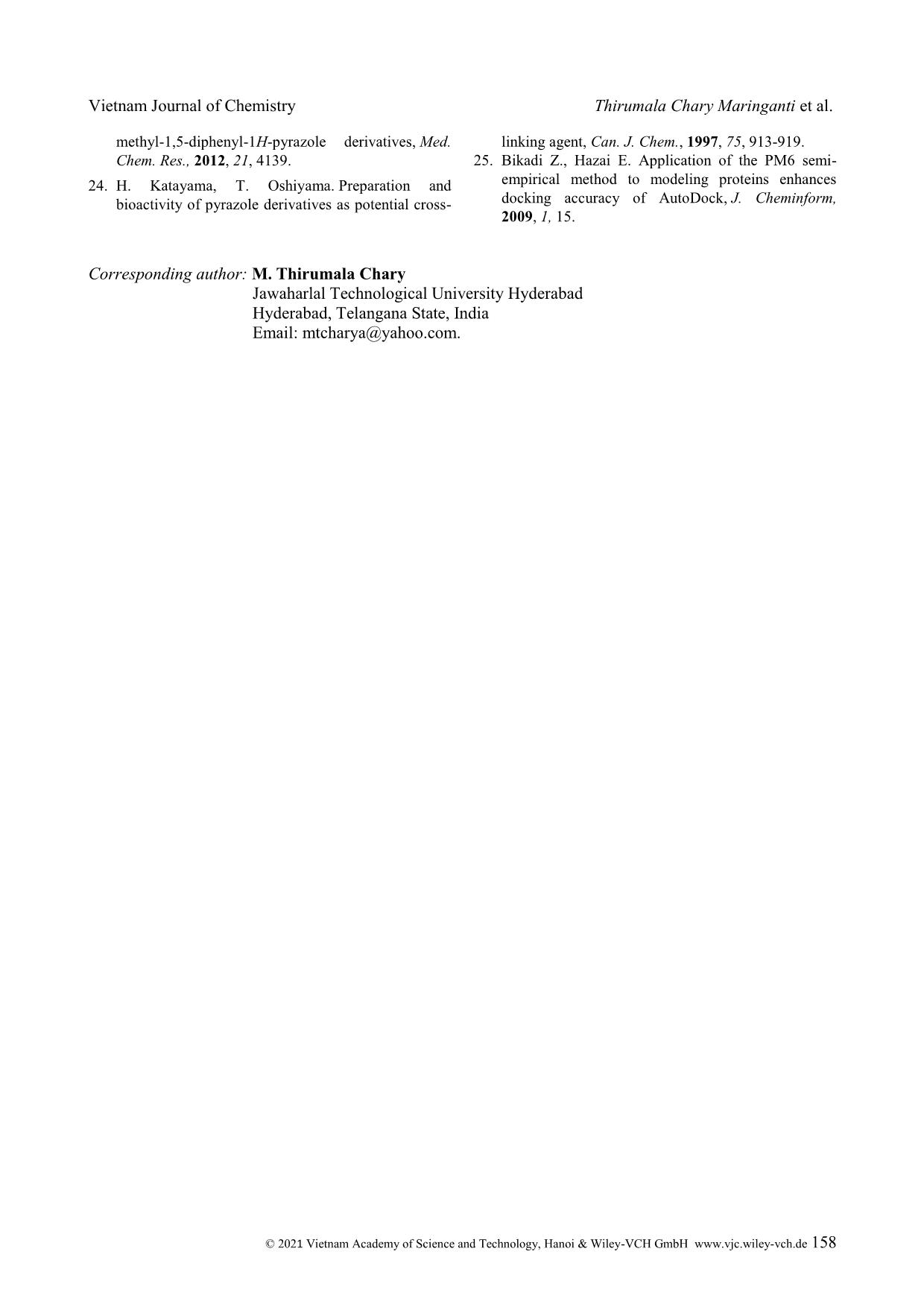
Trang 6
Bạn đang xem tài liệu "An efficient synthesis, characterization and docking studies of 2-Methoxy-3-(1-substituted-1H-pyrazol-3-yl)quinoxalines", để tải tài liệu gốc về máy hãy click vào nút Download ở trên
Tóm tắt nội dung tài liệu: An efficient synthesis, characterization and docking studies of 2-Methoxy-3-(1-substituted-1H-pyrazol-3-yl)quinoxalines
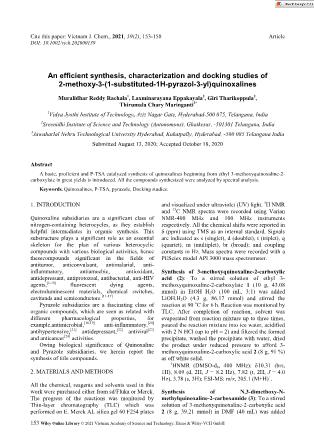
Cite this paper: Vietnam J. Chem., 2021, 59(2), 153-158 Article DOI: 10.1002/vjch.202000139 153 Wiley Online Library © 2021 Vietnam Academy of Science and Technology, Hanoi & Wiley-VCH GmbH An efficient synthesis, characterization and docking studies of 2-methoxy-3-(1-substituted-1H-pyrazol-3-yl)quinoxalines Muralidhar Reddy Rachala 1 , Laxminarayana Eppakayala 2 , Giri Tharikoppula 2 , Thirumala Chary Maringanti 3* 1 Vidya Jyothi Institute of Technology, Aziz Nagar Gate, Hyderabad-500 075, Telangana, India 2 Sreenidhi Institute of Science and Technology (Autonomous), Ghatkesar, -501301 Telangana, India 3 Jawaharlal Nehru Technological University Hyderabad, Kukatpally, Hyderabad, -500 085 Telangana India Submitted August 13, 2020; Accepted October 18, 2020 Abstract A basic, proficient and P-TSA catalyzed synthesis of quinoxalines beginning from ethyl 3-methoxyquinoxaline-2- carboxylate in great yields is introduced. All the compounds synthesized were analyzed by spectral analysis. Keywords. Quinoxalines, P-TSA, pyrazole, Docking studies. 1. INTRODUCTION Quinoxaline subsidiaries are a significant class of nitrogen-containing heterocycles, as they establish helpful intermediates in organic synthesis. This substructure plays a significant role as an essential skeleton for the plan of various heterocyclic compounds with various biological activities, hence thesecompounds significant in the fields of antitumor, anticonvulsant, antimalarial, anti- inflammatory, antiamoebic, antioxidant, antidepressant, antiprotozoal, antibacterial, anti-HIV agents, [1-10] fluorescent dying agents, electroluminescent materials, chemical switches, cavitands and semiconductors. [11-17] Pyrazole subsidiaries are a fascinating class of organic compounds, which are seen as related with different pharmacological properties, for example,antimicrobial, [18,19] anti-inflammatory, [20] antihypertensive, [21] antidepressant, [22] antiviral [23] and anticancer [24] activities. Owing biological significance of Quinoxaline and Pyrazole subsidiaries, we herein report the synthesis of title compounds. 2. MATERIALS AND METHODS All the chemical, reagents and solvents used in this work were purchased either from sd/Fluka or Merck. The progress of the reactions was monitored by Thin-layer chromatography (TLC) which was performed on E. Merck AL silica gel 60 F254 plates and visualized under ultraviolet (UV) light. 1 H NMR and 13 C NMR spectra were recorded using Varian NMR‐400 MHz and 100 MHz instruments respectively. All the chemical shifts were reported in δ (ppm) using TMS as an internal standard. Signals are indicated as s (singlet), d (doublet), t (triplet), q (quartet), m (multiplet), br (broad); and coupling constants in Hz. Mass spectra were recorded with a PESciex model API 3000 mass spectrometer. Synthesis of 3-methoxyquinoxaline-2-carboxylic acid (2): To a stirred solution of ethyl 3- methoxyquinoxaline-2-carboxylate 1 (10 g, 43.08 mmol) in EtOH H2O (100 mL, 3:1) was added LiOH.H2O (4.3 g, 86.17 mmol) and stirred the reaction at 90 o C for 6 h. Reaction was monitored by TLC. After completion of reaction, solvent was evaporated from reaction mixture up to three times, poured the reaction mixture into ice water, acidified with 2 N HCl (up to pH = 2) and filtered the formed precipitate, washed the precipitate with water, dried the product under reduced pressure to afford 3- methoxyquinoxaline-2-carboxylic acid 2 (8 g, 91 %) as off white solid. 1 HNMR (DMSO-d6, 400 MHz): 10.31 (brs, 1H), 8.09 (d, 2H, J = 8.2 Hz), 7.82 (t, 2H, J = 4.0 Hz), 3.78 (s, 3H); ESI-MS: m/z, 205.1 (M+H) + . Synthesis of N,3-dimethoxy-N- methylquinoxaline-2-carboxamide (3): To a stirred solution of 3-methoxyquinoxaline-2-carboxylic acid 2 (8 g, 39.21 mmol) in DMF (40 mL) was added Vietnam Journal of Chemistry Thirumala Chary Maringanti et al. © 2021 Vietnam Academy of Science and Technology, Hanoi & Wiley-VCH GmbH www.vjc.wiley-vch.de 154 DIPEA(20.2 g, 156.8 mmol), HOBT(10.59 g, 78.43 mmol), EDC.HCl (15 g, 78.43 mmol) and stirred the reaction at room temperature for 15 min. then added N,O dimethyl hydroxylamine (2.87 g, 47.05 mmol) and stirred the reaction at room temperature for 18 h. After completion of reaction, reaction mixture was poured into water and filtered the formed precipitate, dried the precipitate under reduced pressure to afford N,3-dimethoxy-N-methylquinoxaline-2- carboxamide 3 (8 g, 83 %) as brown solid. 1 HNMR (DMSO-d6, 400 MHz): 8.11 (d, 2H, J = 8.0 Hz), 7.81 (t, 2H, J = 8.0 Hz, 3.2 Hz);2.79 (s, 3H), 3.52 (s, 3H), 3.72 (s, 3H). ESI-MS: m/z, 247.9 (M+H) + . N N N N O N N O O N N N O O HO N N O O O 1 2 3 4 6 a-d O NH N N O O N O N N O O R-NH-NH2, P-TSA 5 R DMF-DMA MeMgBr, THF EtOH, 90 0C, 6 h EDC.HCl, HOBT DMF, DIPEA RT, 12 h 0 0C-RT, 6 h DMF, 90 0C, 18 h EtOH, 100 0C, 6 h R= H, Methyl, Ethyl, Phenyl LiOH.H2O Scheme 1: Synthesis of 2-methoxy-3-(1-substituted-1H-pyrazol-3-yl) quinoxalines Synthesis of 1-(2-methoxyquinoxalin-3-yl) ethanone (4): To a stirred solution of N,3- dimethoxy-N-methylquinoxaline-2-carboxamide 3 (6g, 24.29 mmol) in THF (60 mL) at -78 o C was added methyl magnesium bromide solution (16.19 mL, 3 M, 48.58 mmol) in diethyl ether as drop wise and stirred the reaction at room temperature for 6h. Reaction was monitored by TLC. After completion of reaction, cooled the reaction mixture to 0 o C and quenched with sat. NH4Cl solution, poured the reaction mixture into ice water, extracted with EtOAc, combined extracts were washed with water followed by brine solution. Dried the extracts over anhy.Na2SO4 and evaporated the solvent to afford crude product. Crude product was purified by silica gel (60-120) column chromatography; product was eluted at 70 % ethyl acetate in pet ether to afford 1- (2-methoxyquinoxalin-3-yl) ethanone 4 (4.1 g, 85 %) as off brown solid. 1 H-NMR (DMSO-d6, 400 MHz): 8.02 (d, 2H, J = 8.0 Hz), 7.75 (t, 2H, J = 8.0 Hz), 3.78 (s, 3H), 2.24 (s, 3H); ESI-MS: m/z, 202.9 (M+H) + Synthesis of 3-(dimethylamino)-1-(3- methoxyquinoxalin-2-yl)prop-2-en-1-one (5): To a stirred solution of 1-(2-methoxyquinoxalin-3-yl) ethanone 4 (4 g, 19.80 mmol) in DMF (20 mL) was added DMF-DMA (2.17 g, 29.70 mmol) at room temperature and stirred the reaction at 100 o C for 18 h. Reaction was monitored by TLC. After completion of reaction, reaction mixture was poured into ice water, extracted with EtOAc, combined extracts were washed with water, brine solution. Dried the extracts over anhy.Na2SO4 and evaporated the solvent to afford crude product. Crude product was purified by silica gel (60-120) column chromatography; product was eluted at 3 % MeOH in DCM to afford 2-methoxy-3-(1-alkyl-1H-pyrazol- 3-yl) quinoxaline 5 (3.75 g, 75 %) as gummy liquid. 1 H-NMR (DMSO-d6, 400 MHz): 8.02 (d, 2H, J = 7.8 Hz), 7.78 (t, 2H, J = 7.8 Hz), 7.22 (d, 1H, J = 8.0 Hz), 6.73 (d, 8 Hz), 3.78 (s, 3H), 2.8 (s, 3H), 2.68 (s, 3H); ESI-MS: m/z, 257.9 (M+H) + Synthesis of 2-methoxy-3-(1-alkyl-1H-pyrazol-3- yl) quinoxaline (6): To a stirred solution of 3- (dimethylamino)-1-(3-methoxyquinoxalin-2- yl)prop-2-en-1-one 5 (1 g, 3.88 mmol) in EtOH (10 mL) was added hydrazine derivatives (3.88 mmol), P-TSA (134 mg, 0.77 mmol) at room temperature and stirred the reaction at 100 o C for 18 h. Reaction was monitored by TLC. After completion of reaction, reaction mixture was poured into water and filtered the formed precipitate, dried the precipitate under reduced pressure to afford crude product. Crude product was purified by silica gel (60-120) column chromatography, product was eluted at 2-3 % MeOH in DCM to afford 2-methoxy-3-(1-alkyl- Vietnam Journal of Chemistry An efficient synthesis, characterization and docking © 2021 Vietnam Academy of Science and Technology, Hanoi & Wiley-VCH GmbH www.vjc.wiley-vch.de 155 1H-pyrazol-3-yl) quinoxaline 6(a-d) and yields of the products varied between 80-95 %. By adapting this procedure the compounds 6(a-d) were synthesized. 2-methoxy-3-(1H-pyrazol-3-yl)quinoxaline (6a): Yield: 89 %; 1 H-NMR (DMSO-d6, 400 MHz): 10.26 (brs, 1H), 8.11 (d, 2H, J = 7.8 Hz), 7.94 (d, 1H, J = 9.8 Hz), 7.82 (t, 2H, J = 8.0 Hz), 7.63 (d, 1H, J = 9.8 Hz), 3.75 (s, 3H); ESI-MS: m/z 227 (M+H) + 2-methoxy-3-(1-methyl-1H-pyrazol-3- yl)quinoxaline (6b): Yield: 80 %; 1 H-NMR (DMSO-d6, 400 MHz): 8.13 (d, 2H, J = 7.8 Hz), 7.93 (d, 1H, J = 9.8 Hz), 7.80 (t, 2H, J = 4.0 Hz), 7.62 (d, 1H, J = 9.8 Hz), 3.74 (s, 3H), 2.61 (s, 3H); ESI–MS: m/z, 241 (M+H)+. 2-methoxy-3-(1-ethyl-1H-pyrazol-3- yl)quinoxaline (6c): Yield: 85 %; 1 H-NMR (DMSO-d6, 400 MHz): 8.10 (d, 2H, J = 7.8 Hz), 7.91 (d, 1H, J = 9.8 Hz), 7.79 (t, 2H, J = 8.0 Hz), 7.64 (d, 1H, J = 9.8 Hz), 3.75 (s, 3H), 2.62 (m, 2H), 1.31 (t, 3H, J = 3.5 Hz); ESI-MS: m/z, 255 (M+H) + . 2-methoxy-3-(1-phenyl-1H-pyrazol-3- yl)quinoxaline (6d): Yield 95 %; 1 H-NMR (DMSO- d6, 400 MHz): 8.12 (d, 2H, J = 7.8 Hz), 7.95 (d, 1H, J = 9.8 Hz), 7.80 (t, 2H, J = 8.0 Hz), 7.61 (d, 1H, J = 9.8 Hz), 7.40 (m, 5H), 3.78 (s, 3H); 13 C NMR (DMSO-d6, 100 MHz): 155.02, 148.08, 142.01, 139.01, 138.0, 137.8, 132.2, 131.2, 128.8, 126.2, 122.05, 119.8, 110.80, 56.10; ESI-MS: m/z, 302.9 (M+H) + . 3. RESULTS AND DISCUSSION 3.1. Chemistry The target compounds 6a-d was prepared as outlined in scheme 1. The compound ethyl 3- methoxyquinoxaline-2-carboxylate 1 was reacted with LiOH.H2O in presence EtOH:Water to afford 3- methoxyquinoxaline-2-carboxylic acid 2 as 90 % yield. The resulting product was treated with N,O dimethyl hydroxylamine in presence of EDC.HCl, HOBT and afford N,3-dimethoxy-N- methylquinoxaline-2-carboxamide 3 as 87 % yield. Resulted amide was treated with methyl magnesium bromide in THF then formed corresponding 1-(2- methoxyquinoxalin-3-yl)ethanone 4 as 85 % yield. This ketone was further treated with DMF-DMA and get 2-methoxy-3-(1-alkyl-1H-pyrazol-3-yl) quinoxaline 5 as 80 % yield. This compound 5 was treated with different hydrazine derivatives in EtOH in presence of P-TSA to afford corresponding substituted pyrazole products 6(a-d) in excellent yield. The structures of synthesized compounds were confirmed by spectral analysis. The 1 H NMR spectrum of compound 6d showed a doublet peak at δ 8.12, 7.95, 7.80, 7.61 corresponding to quinoxaline and pyrazole rings, multiplet at 7.40 indicating phenyl group and 3.78 singlet for three protons suggested the presence of methyl group. In the 13 C NMR spectrum of compound 8a peak at δ 56.1 indicated the presence of ether group and the other signals corresponding to aromatic carbons. Further support was also obtained from the mass spectrum which showed peak at m/z = 302.9 corresponding to [(M+H) + ] of the compound 6d. 3.2. Docking studies The protein 1jff (tubulin) was downloaded from RSC PDB and was docked. [25] Compound 6d was the most efficient for inhibiting the structural protein as shown in tables 1 and 2. The major aminoacids which were involved in the binding of the compounds were tyrosine, asparagines, alanine, glutamine, glutamic acid, leucine, serine (figure 1). Table 1: Docking results for Free energy of Binding Rank Est. Free Energy of Binding Est. Inhibition Constant, Ki vdW + Hbond + desolv Energy Electrostatic Energy Total Intermolec. Energy Frequency Interact. Surface 1. -4.45 kcal/mol 547.79 M -5.21 kcal/mol -0.07 kcal/mol -5.28 kcal/mol 50 % 586.527 Vietnam Journal of Chemistry Thirumala Chary Maringanti et al. © 2021 Vietnam Academy of Science and Technology, Hanoi & Wiley-VCH GmbH www.vjc.wiley-vch.de 156 Table 2: Docking results of hydrogen bonding Hydrogen bonds Polar Hydrophobic pi-pi Other N2 () [3.27] – SER38 (O, OG) N4 () [3.63] – SER38 (OG) C14 () [3.39] – PRO35 (CB) C13 () [3.31] – TYR55 (CD1, CE1) C7 () [3.90] – SER38 (CB) N3 () [2.66] – SER38 (CB, OG) C9 () [3.89] – PRO40 (CG) C14 () [3.79] – TYR55 (CD1) C8 () [3.53] – SER38 (CB, OG) C10 () [3.46] – TYR55 (CE1, CZ) C18 () [3.64] – SER38 (CB) C12 () [3.78] – TYR55 (CE1) C9 () [3.35] – SER38 (OG) C13 () [3.89] – SER38 (OG) N2 () [3.67] – PRO40 (CB, CG) N3 () [3.83] – PRO40 (CG) C2 () [3.04] – GLN42 (CD, NE2, OE1) C1 () [3.31] – GLN42 (OE1) N4 () [3.74] – TYR55 (CE1) C11 () [3.76] – TYR55 (OH) C10 () [3.51] – TYR55 (OH) C2 () [3.87] – LYS468 (NZ) Figure 1: Bonding involved in the binding of the ligand to the tubulin Vietnam Journal of Chemistry An efficient synthesis, characterization and docking © 2021 Vietnam Academy of Science and Technology, Hanoi & Wiley-VCH GmbH www.vjc.wiley-vch.de 157 Acknowledgements. The authors are thankful to JNT University Hyderabad and Vidya Jyothi Institute of Technology for providing the research facilities to carry out this work. REFERENCES 1. S. D. Undevia, F. Innocenti, J. A. Ramirez, L. House, A. A. Desai, L. A. Skoog, D. A. Singh, T. Karrison, H, L. Kindle, M. J. Ratain. A phase I and pharmacokinetic study of the quinoxaline antitumour Agent R(+)XK469 in patients with advanced solid tumours, Eur. J. Cancer, 2008, 44(12), 1684-1692. 2. P. Corona, A. Carta, M. Loriga, G. Vitale, G. Paglietti. Synthesis and in vitro antitumor activity of new quinoxaline derivatives, Eur. J. Med. Chem., 2009, 44(4), 1579-1591. 3. C. Urquiola, D. Gambino, M. Cabrera. New copper- based complexes with quinoxaline N1,N4-dioxide derivatives, potential antitumoral agents, J. Inorg. Biochem., 2008, 102(1), 119-126. 4. Q. Weng, D. Wang, P. Guo. Q39, a novel synthetic Quinoxaline 1,4-Di-N-oxide compound with anti- cancer activity in hypoxia, Eur. J. Pharm., 2008, 581(3), 262-269. 5. S. Wagle, A. V. Adhikari, N. S. Kumari. Synthesis of some new 4-styryltetrazolo[1,5-a]quinoxaline and 1- substituted-4-styryl[1,2,4]triazolo[4,3-a]quinoxaline derivatives as potent anticonvulsants, Eur. J. Med. Chem., 2009, 44(3), 1135-1143. 6. E. Vicente, L. M. Lima, E. Bongard. Synthesis and structure-activity relationship of 3-phenylquinoxaline 1,4-di-N-oxide derivatives as antimalarial agents, Eur. J. Med. Chem., 2008, 43(9), 1903-1910. 7. A. Burguete, E. Pontiki, V. D. Hadjipavlou-Litina. Synthesis and anti-inflammatory/antioxidant activities of some new ring substituted 3-phenyl-1- (1,4-di-N-oxide quinoxalin-2-yl)-2-propen-1-one derivatives and of their 4,5-dihydro-(1H)-pyrazole analogues, Bioorg. Med. Chem. Lett., 2007, 17(23), 6439-6443. 8. A. Budakoti, A. R. Bhat, A. Azam. Synthesis of new 2-(5-substituted-3-phenyl-2-pyrazolinyl)-1,3- thiazolino[5,4-b]quinoxaline derivatives and evaluation of their antiamoebic activity, Eur. J. Med. Chem., 2009, 44(3), 1317-1325. 9. W. He, M. R. Myers, B. Hanney. Potent quinoxaline- based inhibitors of PDGF receptor tyrosine kinase activity. Part 2: the synthesis and biological activities of RPR127963 an orally bioavailable inhibitor, Bioorg. Med. Chem. Lett., 2003, 13(18), 3097-3100. 10. Y. B. Kim, Y. H. Kim, J. Y. Park, S. K. Kim. Synthesis and biological activity of new quinoxaline antibiotics of echinomycin analogues, Bioorg. Med. Chem. Lett., 2004, 14(2), 541-544. 11. J. Y. Jaung. Synthesis and halochromism of new quinoxaline fluorescent dyes, Dyes Pigm., 2006, 71(3), 245-250. 12. Q. Y. Zhang, B. K. Liu, W. Q. Chen, Q. Wu, X. F. Lin. A green protocol for synthesis of benzo-fused N,S-, N,O- and N,N-heterocycles in water, Green Chem., 2008, 10(9), 972-977. 13. K. R. J. Thomas, M. Velusamy, T. Lin Jiann, C. H. Chuen, Y. T. Tao. Chromophore-labeled quinoxaline derivatives as efficient electroluminescent materials. Chem. Mat., 2005, 17(7), 1860-1866. 14. M. J. Crossley, L. A. Johnston. Laterally-extended porphyrin systems incorporating a switchable unit. Chem. Comn., 2002, 10, 1122-1123. 15. S. Dailey, W. J. Feast, R. J. Peace, I. C. Sage, S. Till, E. L. Wood. Synthesis and device characterisation of side-chain polymer electron transport materials for organic semiconductor applications, J. Mat. Chem., 2001, 11(9), 2238-2243. 16. A. Katoh, T. Yoshida, J. Ohkanda. Synthesis of quinoxaline derivatives bearing the styryl and phenylethynyl groups and application to a fluorescence derivatization reagent, Heterocycles. 2000, 52(2), 911-920. 17. J. L. Sessler, H. Maeda, T. Mizuno, V. M. Lynch, H. Furuta. Quinoxaline-bridged porphyrinoids, J. the Amer. Chem. Soc., 2002, 124(45), 13474-13479. 18. M. Rahimizadeh, M. Pordel, M. Bakavoli, S. Rezaeian, A. Sadeghian. Synthesis and antibacterial activity of some new derivatives of pyrazole, World J. Microbiol. Biotechnol., 2010, 26, 317. 19. C. S. Reddy, M. V. Devi, G. R. Kumar, Rao L. S. A. Nagaraj. Synthesis and antimicrobial activity of linked heterocyclics containing pyrazole-pyrimidine rings, Ind. Chem., 2011, 50B, 1181. 20. M. Amir, S. Kumar. Synthesis and anti- inflammatory, analgesic, ulcerogenic and lipid peroxidation activities of 3, 5-dimethyl pyrazoles, 3- methylpyrazol-5-ones and 3,5-disubstituted pyrazolines, Ind. J. Chem., 2005, 44B, 2532. 21. C. Almansa, L. A. Gómez, F. L. Cavaleanti, A. F. de Arriba, J. García-Rafanell, J. Forn. Synthesis and SAR of a New Series of COX-2-Selective Inhibitors: Pyrazolo[1,5-a]pyrimidines, J. Med. Chem., 1997, 40, 547. 22. D. M. Bailey, P. E. Hansen, A. G. Hlavac, E. R. Baizman, J. Pearl, A. F. DeFelice, M. E. Feigenson. 3,4-Diphenyl-1H-pyrazole-1-propanamine antidepressants, J. Med. Chem., 1985, 28, 256. 23. A. S. Tantawy, M. N. A. Nasr, M. A. A. El-Sayed, S. S. Tawfik. Synthesis and antiviral activity of new 3- Vietnam Journal of Chemistry Thirumala Chary Maringanti et al. © 2021 Vietnam Academy of Science and Technology, Hanoi & Wiley-VCH GmbH www.vjc.wiley-vch.de 158 methyl-1,5-diphenyl-1H-pyrazole derivatives, Med. Chem. Res., 2012, 21, 4139. 24. H. Katayama, T. Oshiyama. Preparation and bioactivity of pyrazole derivatives as potential cross- linking agent, Can. J. Chem., 1997, 75, 913-919. 25. Bikadi Z., Hazai E. Application of the PM6 semi- empirical method to modeling proteins enhances docking accuracy of AutoDock, J. Cheminform, 2009, 1, 15. Corresponding author: M. Thirumala Chary Jawaharlal Technological University Hyderabad Hyderabad, Telangana State, India Email: mtcharya@yahoo.com.
File đính kèm:
 an_efficient_synthesis_characterization_and_docking_studies.pdf
an_efficient_synthesis_characterization_and_docking_studies.pdf

